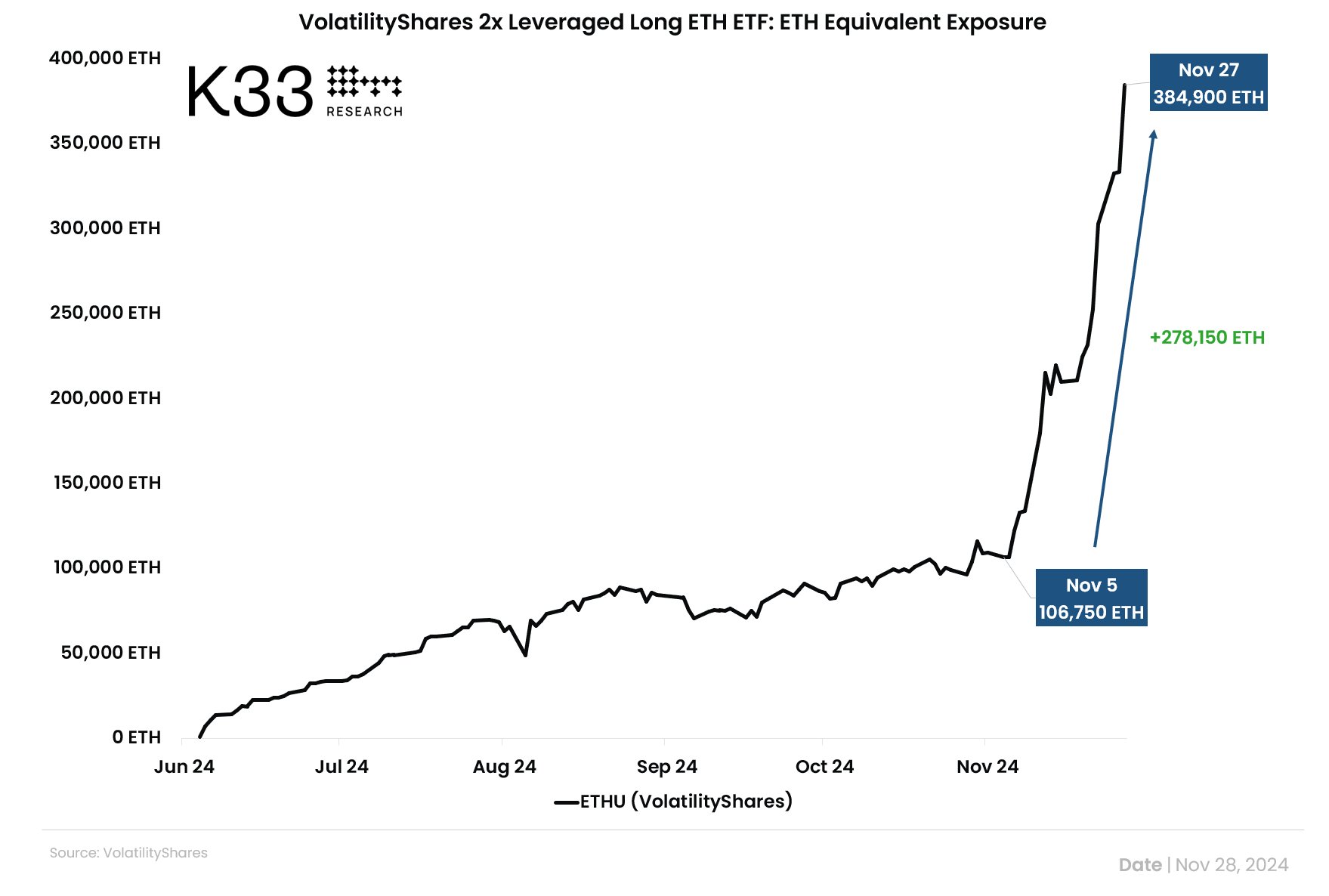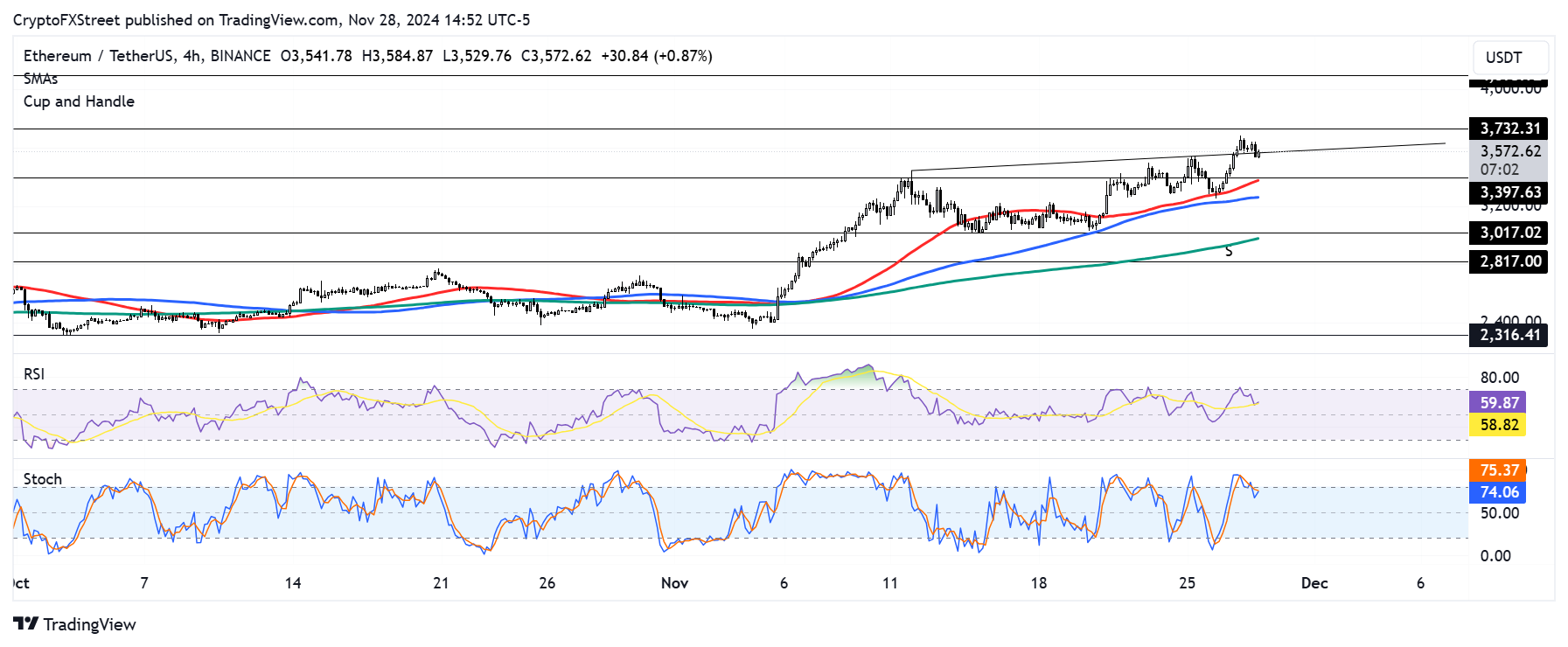Ethereum Price Forecast: ETH could test its all-time high resistance following high institutional interest
Ethereum price today: $3,570
- Ethereum ETFs' increased net inflows could send ETH to test its all-time high resistance of $4,868.
- Ethereum investors have shown an appetite for risk as VolatilityShares leveraged long ETF holdings skyrocketed by 160%.
- ETH needs to stay above $3,400 and the 50-day SMA to maintain a bullish structure.
Ethereum is down 1% on Thursday and could rally toward its all-time high of $4,868 following increased institutional interest. This is evidenced by buying pressure across ETH ETFs and leverage products.
Ethereum sees increased institutional interest
Ethereum has been at the center of attention among investors over the past week as it continues to see high demand from institutional investors
ETH ETFs posted a fourth consecutive day of positive flows after recording net inflows of $90.1 million on Wednesday. This has sent their cumulative net inflows to $243 million, despite over $3.37 billion outflows in Grayscale's ETHE.
"These healthy inflows highlight the market's growing optimism despite this week's retracement," wrote QCP analysts in a Thursday note. "Given that ETH has lagged behind BTC and SOL in the current rally, its recent strength supports the case for it to retest its all-time high of $4,868 (+35.4%)" they added.
Ethereum investors have also been showing an appetite for risk over the past three weeks.
"Since November 5, the ETH equivalent exposure in the VolatilityShares 2x leveraged long ETH ETF (ETHU) has increased by 278,150 ETH (+160%!)," wrote Vetle Lunde, Head of Research at K33 Research in an X post on Thursday. As a result, VolatilityShares ETH holdings have surpassed 50% of CME's open interest.

ETHU Holdings | K33 Research
However, as prices rise, investors may be tempted to book profits by selling portions of their holdings.
For example, Ethereum co-founder Jeffrey Wilcke potentially sold a part of his ETH holdings on Thursday. According to crypto analytics platform Arkham, Wilcke deposited 20,000 ETH worth $72.5 million to Kraken. Wilcke still holds 106,000 ETH worth around $384 million.
Ethereum Price Forecast: $3,400 support and 50-day SMA crucial to maintain bullish structure
Ethereum is down 1% after sustaining $55.45 million in liquidations in the past 24 hours, per Coinglass data. Liquidated long and short positions accounted for $25.79 million and $29.65 million, respectively.
On the 4-hour chart, Ethereum saw a rejection as it approached the $3,732 resistance level and is currently testing a key ascending trendline support.

ETH/USDT 4-hour chart
If the the top altcoin continues declining, it could find support near the $3,400 level and the 50-day Simple Moving Average (SMA). A bounces off this level, could see ETH test the $3,732 resistance.
However, a decline below $3,400 could send ETH toward the $3,000 psychological level, which buyers have defended for the past two weeks.
Meanwhile, Coinglass data shows that ETH's highest liquidation leverage is concentrated near the $3,526 price, meaning the top altcoin could see high volatility if it approaches this price level.
The Relative Strength Index RSI and Stochastic Oscillator momentum indicators are above their neutral levels, indicating bullish momentum is still prevalent.
A candlestick close below $2,817 would invalidate the thesis.
Ethereum FAQs
Ethereum is a decentralized open-source blockchain with smart contracts functionality. Its native currency Ether (ETH), is the second-largest cryptocurrency and number one altcoin by market capitalization. The Ethereum network is tailored for building crypto solutions like decentralized finance (DeFi), GameFi, non-fungible tokens (NFTs), decentralized autonomous organizations (DAOs), etc.
Ethereum is a public decentralized blockchain technology, where developers can build and deploy applications that function without the need for a central authority. To make this easier, the network leverages the Solidity programming language and Ethereum virtual machine which helps developers create and launch applications with smart contract functionality.
Smart contracts are publicly verifiable codes that automates agreements between two or more parties. Basically, these codes self-execute encoded actions when predetermined conditions are met.
Staking is a process of earning yield on your idle crypto assets by locking them in a crypto protocol for a specified duration as a means of contributing to its security. Ethereum transitioned from a Proof-of-Work (PoW) to a Proof-of-Stake (PoS) consensus mechanism on September 15, 2022, in an event christened “The Merge.” The Merge was a key part of Ethereum's roadmap to achieve high-level scalability, decentralization and security while remaining sustainable. Unlike PoW, which requires the use of expensive hardware, PoS reduces the barrier of entry for validators by leveraging the use of crypto tokens as the core foundation of its consensus process.
Gas is the unit for measuring transaction fees that users pay for conducting transactions on Ethereum. During periods of network congestion, gas can be extremely high, causing validators to prioritize transactions based on their fees.

